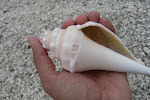I just wanted to talk stories and share some new finds. The latest is another sling stone, or as the
Chamorros called them, acho' atupat (or atupak). The indigenous people of the Marianas produced
them as early as the Latte Period/Phase (1000-250 BP). History books describe
them as egg or acorn-shaped stones fashioned with “jasper-like” stone, or with
sun or fire-hardened clay. People now use the words biconical or
football-shaped to describe them. The ancient people wielded them with deadly
accuracy. This one is made of limestone and one end is worn off or damaged.
Recent rains are really wearing down to the older soil layers
revealing artifacts. Erosion from cars
also help expose them, but if you take a look at the sling stone in situ, they
are easy to miss.
I recently found some broken adze heads (an adze is higam
in Chamorro) made out of a giant clam (hima in Chamorro)
shell. Cars drive on roads that may have exposed some artifacts such as
these and can often break or damage them. This one was partially buried but already broken in 2and maybe 80% of it missing. It cleaned up nicely though with a little soapy water and an old toothbrush.
This one is a real nice specimen, thick on the sides. Too bad the blade is not intact but it is almost complete.
They are easy to overlook since there are usually a lot of hima fragments strewn about. You have to pay attention to their shapes but once you're familiar they are easy to distinguish from shells that weren't worked on.
Check out this basalt ball. I think these were used as deep sea fishing
weights. The grooves show where coconut
sennit tied it down. I got too excited digging it out of the soil so I
wasn't able to get an in situ picture.

 This is a strange sling stone that Laurina found. Instead of the more solid basalt or
limestone, it is made out of greenish sandstone. It is porous and holds water on the surface.
This is a strange sling stone that Laurina found. Instead of the more solid basalt or
limestone, it is made out of greenish sandstone. It is porous and holds water on the surface.
Thank you for dropping by to talk stories one more time.
Ti napu,
The Beachcomber










